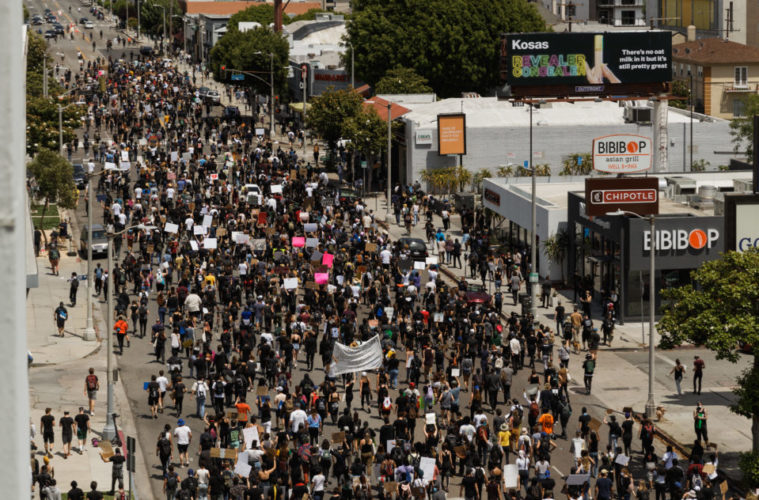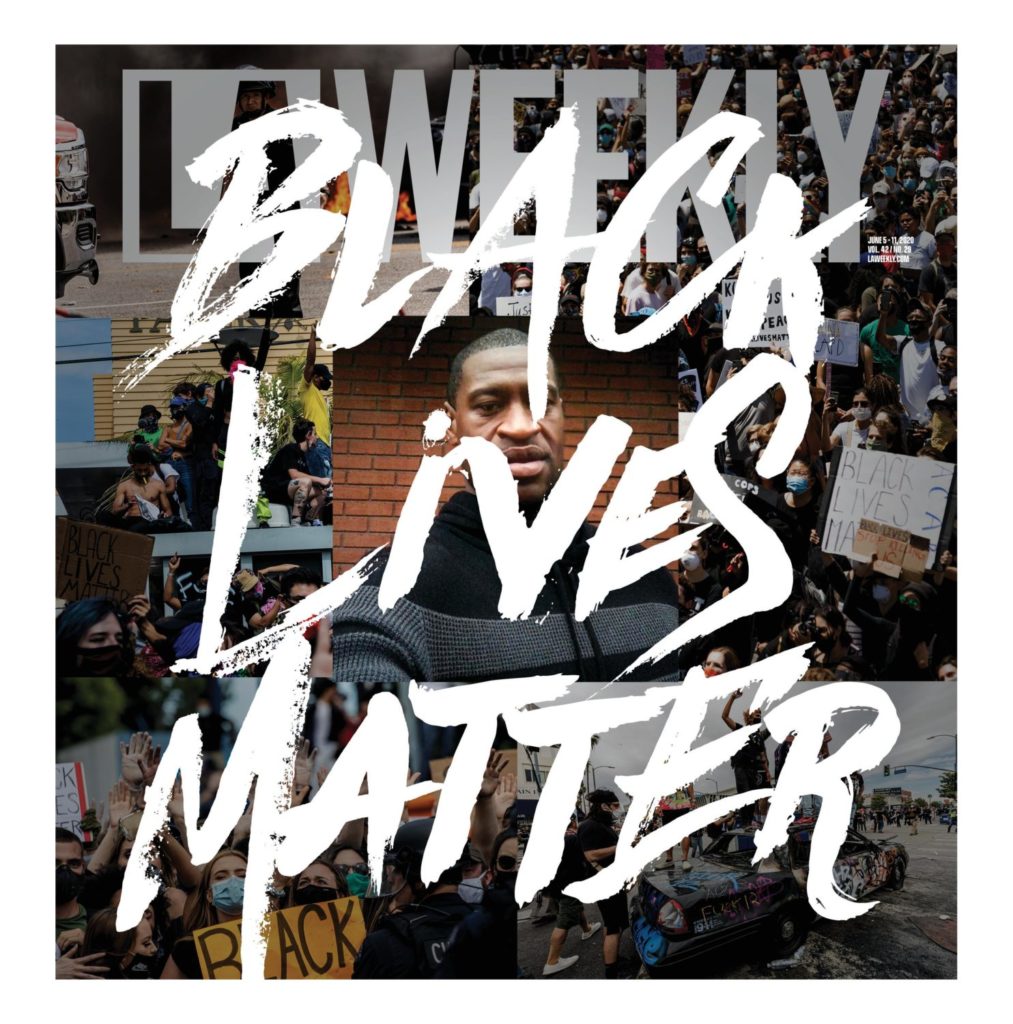On Memorial Day, George Floyd died while being detained by police in Minneapolis, Minnesota. Fifteen hundred miles away, Angelenos took to the streets to protest and voice their anger at police brutality and the killing of people of color.
Converging on Los Angeles’ civic center on Wednesday, May 27, hundreds gathered in front of the Metropolitan Detention Center, chanting “Black Lives Matter!” Camera crews captured a protester falling to the ground from the hood of a CHP cruiser as protesters hurled debris at it.
Demonstrations grew by the day, and by the weekend thousands protested across the city, as did citizens cross the country.
“We really need the media to step up for black people and for justice. We took to the streets with masks on amidst a pandemic to show up for George Floyd, Breonna Taylor, Ahmaud Arbery and so many other black people whose lives have been cut short by the anti-black racism that exists in this country,” Black Lives Matter (BLM-LA) co-founder Patrisse Cullors told L.A. Weekly in a written statement. “We are in pain and we are demanding this country defund the police, to invest in the critical social services that so many of us need during this pandemic moment. This week is our Week Of Action in defense of black lives, where we outline our five demands. We urge Los Angeles to join us and find ways to take action.”
We’ve all seen the video footage of Floyd’s death, showing him on the ground as police officer Derek Chauvin kneels on his neck, Floyd repeatedly saying “I can’t breathe” and pleading for relief. Officers involved in the incident have since been fired, and Chauvin is being charged with second-degree murder.
Hundreds of protesters made their way to downtown Los Angeles on Friday, as the LAPD attempted to break up the crowd after declaring the rally an unlawful assembly.
Around 6 p.m., the protesters made several attempts to march toward freeways, but were blocked by cordons of LAPD officers. A smaller group did split from the crowd and stop traffic on the 110 South Freeway, where they sat and even gathered around the few LAPD officers on the scene. The officers drew their weapons as the group guided them toward the freeway’s center divider, but ultimately it did not escalate at that moment.
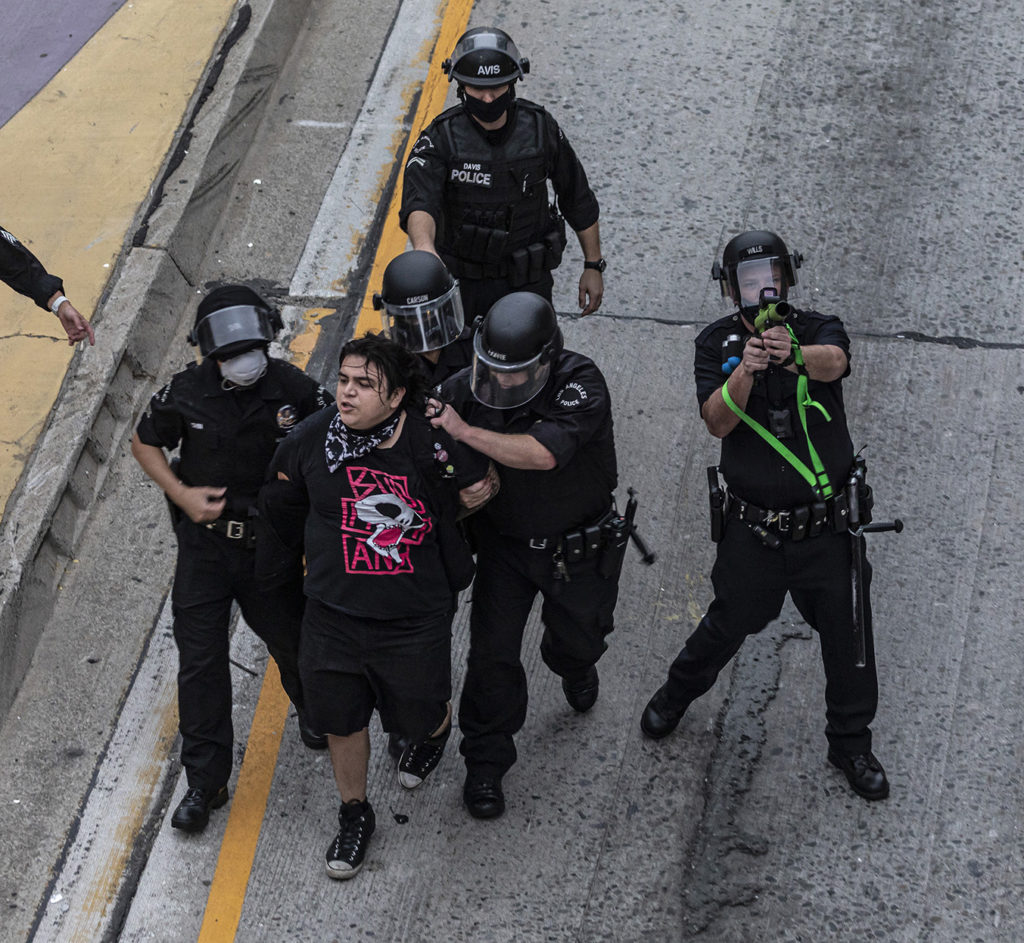
Friday’s demonstrations in downtown L.A. on Friday, May 29 (Ted Soqui)
On city streets, a larger group of the protesters were more vocal. A few got in front of officers and yelled, while non-confrontational citizens attempted to intervene and pull away the more vocal ones.
With local news choppers capturing the scene, a line of officers attempted to guide the marchers away from the freeway on-ramp. Some of the marchers smashed police cruiser windows, and an LAPD officer and a protester wrestled each other to the ground as demonstrators and the LAPD looked on. The officer was then ushered away from the scene.
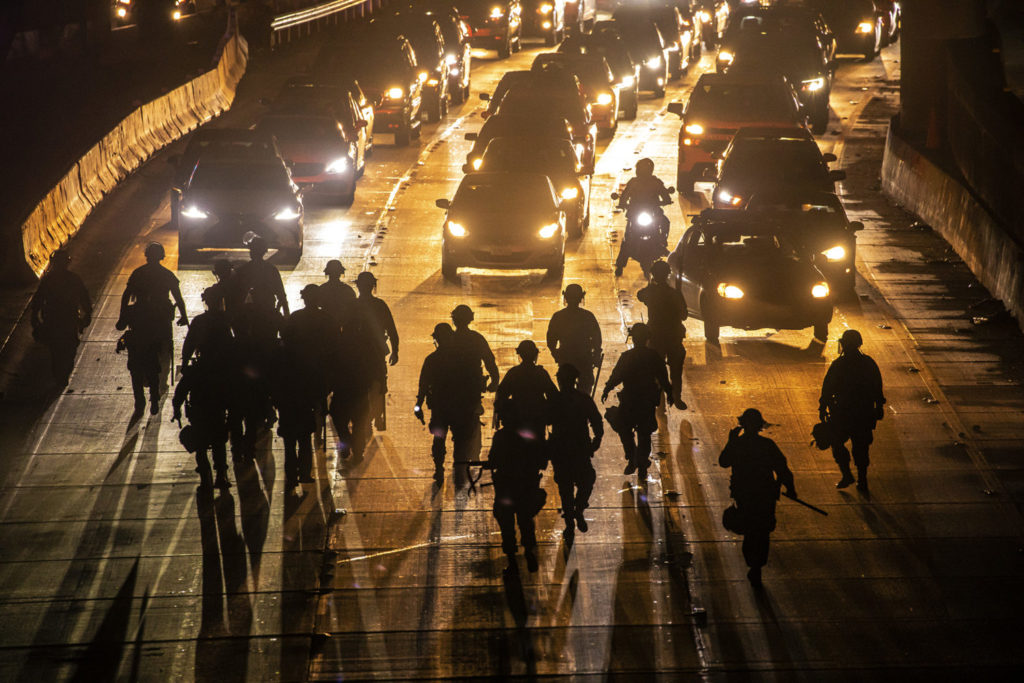
Demonstrators in downtown Los Angeles take over the 110 Freeway on Friday, May 29. (Ted Soqui)
Though L.A. has seen a week of nonviolent protests — some even popped up in relatively removed suburbs such as Irvine and Santa Clarita — it was perhaps Saturday’s events that still proved to be an inflection point. Thousands converged in the Fairfax District for a march organized by BLM-LA. Unlike in 1992, during the protests and riots after the Rodney King acquittals, the seminal moments would occur in a markedly different setting.
“I thought it was important geographically the neighborhood we were meeting up in,” said Celia, a black teaching artist who attended the march. “Because that neighborhood is predominantly white, and it’s important for white Angelenos and huge businesses, successful businesses, in that area to recognize that it’s an Angeleno and American issue.”
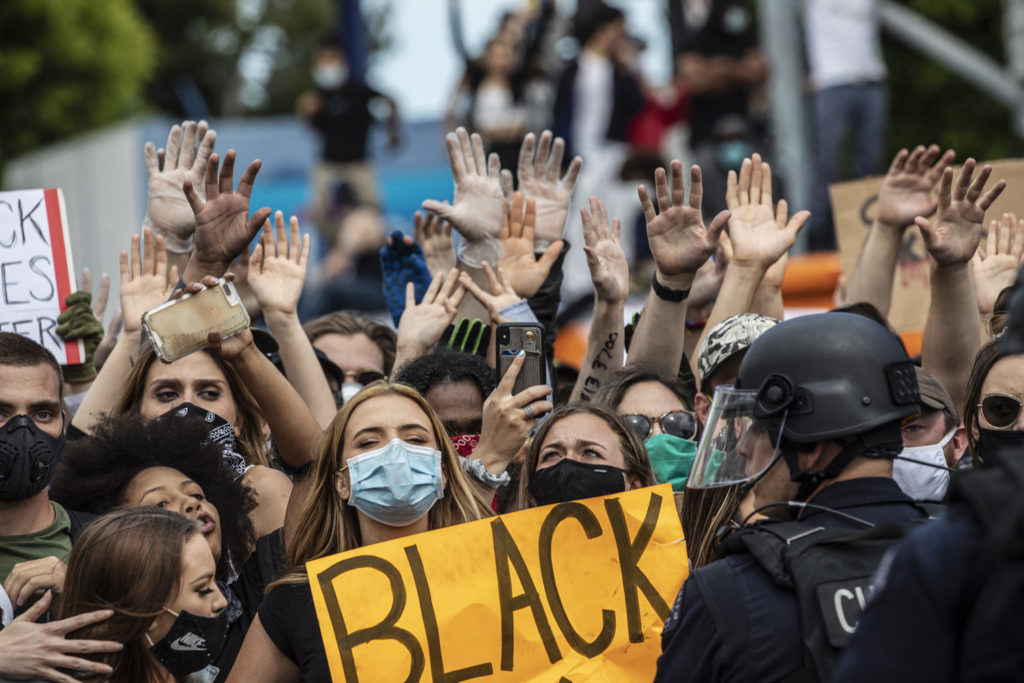
Protesting in the Fairfax District of Los Angeles on Saturday, May 30. (Ted Soqui)
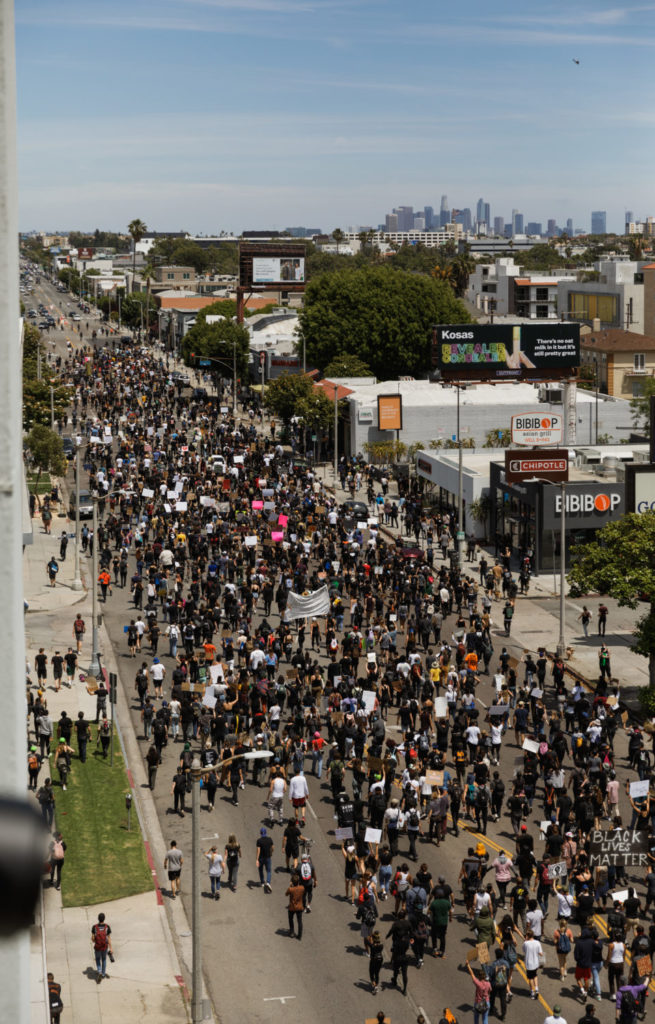
(Jacen Carpenter)
Protesters painted a scene of community, with a largely positive, nonviolent atmosphere.
“I left before things seemed to have gotten really intense, but while I was there it was very emotional and overwhelming to see thousands of people stand in solidarity,” protester Britnee Sweat told L.A. Weekly. “It was a great feeling to have that reassurance that there are so many people who truly believe that black lives do matter.”
“It was incredible, there were so many people and people with care and love and solidarity in their hearts,” recalled Celia. “People were handing out masks, water, snacks — it was very hot, especially with the masks, and we were walking 12 miles.”
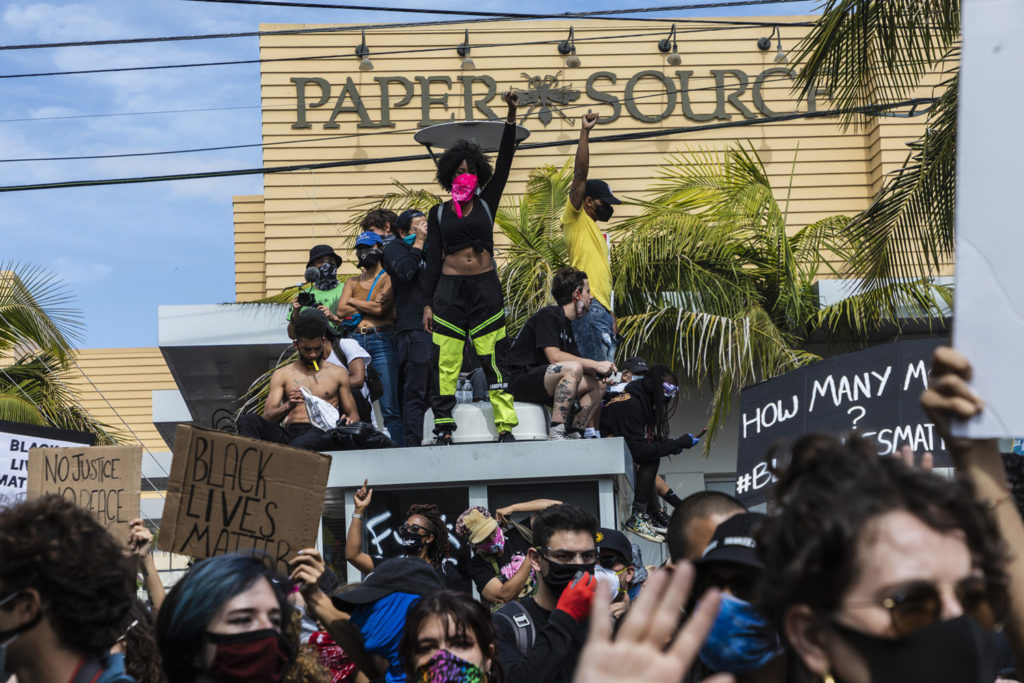
Protesting in the Fairfax District of Los Angeles on Saturday, May 30. (Ted Soqu
Events, however, would take a turn, just as they did earlier in the week when demonstrations took over freeways, trash cans burned, and there was scattered looting of businesses, such as the Target on 7th and Figueroa.
“There were moments of tenseness… The police presence was very powerful and they initiated contact very early on,” said Celia. “We left from Pan Pacific Park and stopped momentarily at 3rd and Fairfax, and they were already shooting rubber bullets at that location.”
Another attendee, Richard, recounted the moment he saw the LAPD advancing, aggressively yelling, as he watched friends get shot with rubber bullets.
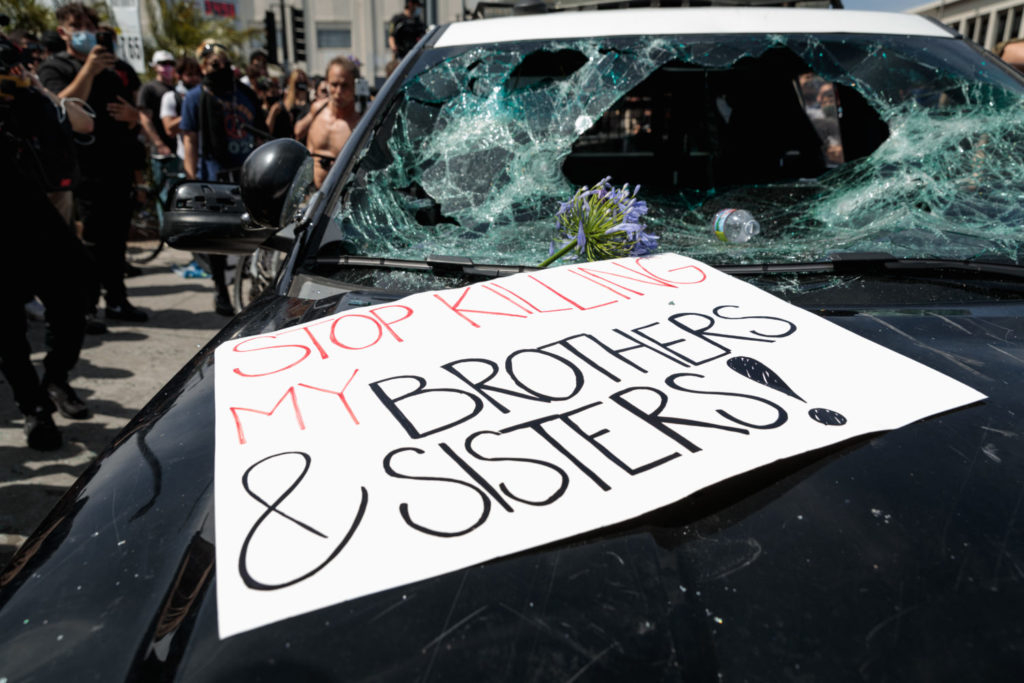
(Jacen Carpenter)
By mid-afternoon, police cars had been torched, businesses were looted and altercations with police broke out. At least five officers would be injured that day and hundreds of protesters arrested, according to the LAPD.
Multiple marchers told L.A. Weekly that people unaffiliated with the nonviolent protest were responsible for the mayhem. Both Mayor Eric Garcetti and Governor Gavin Newsom said they believed out-of-town agitators were sent into the city to disrupt protests, with Garcetti going as far as calling them “organized criminals” and Newsom refusing to give any specific group public acknowledgment.
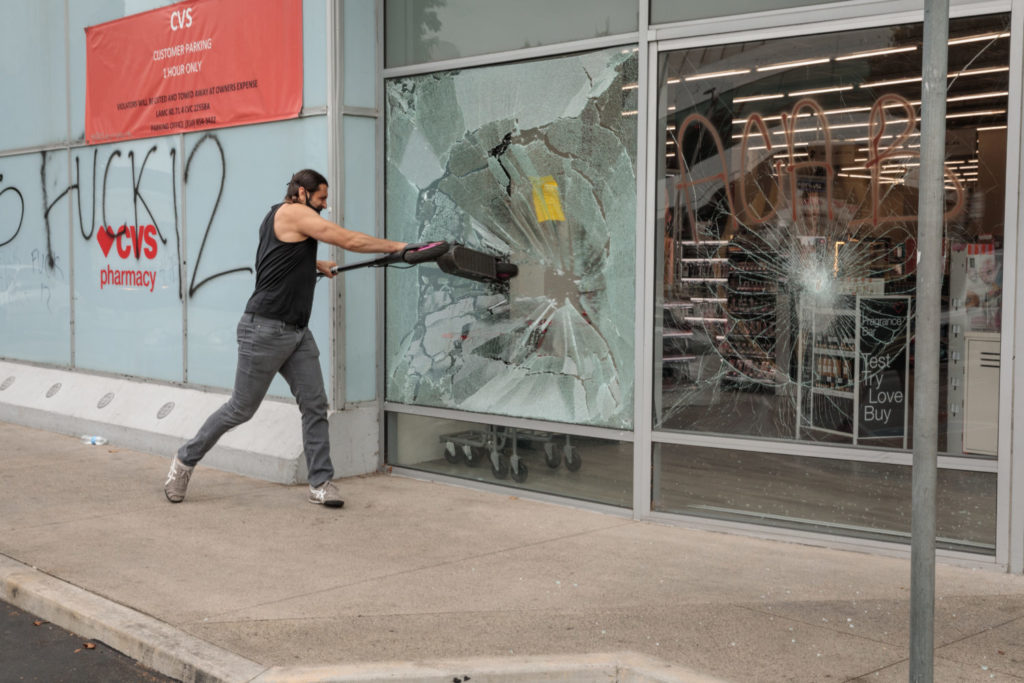
(Jacen Carpenter)
Within hours, Garcetti ordered a curfew of downtown L.A., which by nightfall became citywide. The governor declared a state of emergency as 1,000 National Guard members were deployed to assist law enforcement.
“…At one point, you’ve got to take the temperature of the crowd, and eventually it starts getting ugly, we’ve got hundreds in this area ready to go in,” Garcetti said later.
He also declared, “This is no longer a protest, this is destruction. Looting, stealing or vandalizing have nothing to do with the protest.”
The one-night, citywide curfew would be followed, at the time of this writing, by four consecutive nights of countywide curfews, from evening to early morning. In some localities, curfews began as early as 1 p.m.
Meanwhile, on Monday President Donald Trump controversially threatened to dispatch active-duty military units across the country to “stop the rioting, looting, vandalism, assaults and destruction of property.”
At least 3,000 arrests have been made in L.A. County since protests began — the vast majority for offenses unrelated to looting or rioting.
DeShawn Brown drove from the Valley on Sunday to attend his first protest. Marching from Santa Monica to Venice in a demonstration that was “95 percent peaceful,” he, like many residents, received the official alert for a 6 p.m. curfew at 5:18 p.m. He immediately started walking with a group back to his car, only to be delayed by a labyrinth of street closures and police blockades.
Less than half an hour after curfew and still on Olympic, multiple police cars arrived. Officers leapt out, weapons drawn, yelling “Don’t move!” and “Get on the ground!”
Brown and the group were zip-tied and held on the curb until a bus arrived to transport them to an unhygienic detention center at the Santa Monica Airport. He was finally released with a citation around 2:30 a.m. and returned home at 4:30 a.m.
Brown was one of more than 400 people arrested in Santa Monica on Sunday night. The very next day, LAPD’s Hollywood division reported a daily record — nearly 600 arrests, mostly for curfew violations.
Recalling that night, Brown said he wasn’t scared. “I was doing the right thing for my family members, for my friends, for myself.”
Where Los Angeles goes from this historic, at times combative week remains to be seen. Protests across the nation show no sign of abating in the midst of a global pandemic during which people have been advised to wear face coverings and avoid large gatherings for more than two months.
“I could put together a group of advisers. I could put together another task force. I could promise and promote a few pieces of legislation, but program passing is not problem solving,” Newsom said Monday. “You got to change hearts, you got to change culture, not just laws.”
A six-plus–hour Zoom meeting for the Los Angeles Board of Police Commissioners — its first since the protests began — saw Angeleno after Angeleno call in for two-minute public comment periods while more than 16,000 watched streams online. At times emotional, comments were overwhelmingly critical, even scathing, of the LAPD and the commission’s oversight of the police force.
Many called for Chief Michel Moore to be fired, particularly in light of his quickly retracted and widely panned statement Monday assigning blame to protesters for the death of George Floyd. Others accused local law enforcement of hypocrisy and paying lip service to Floyd, given past police killings of Angelenos.
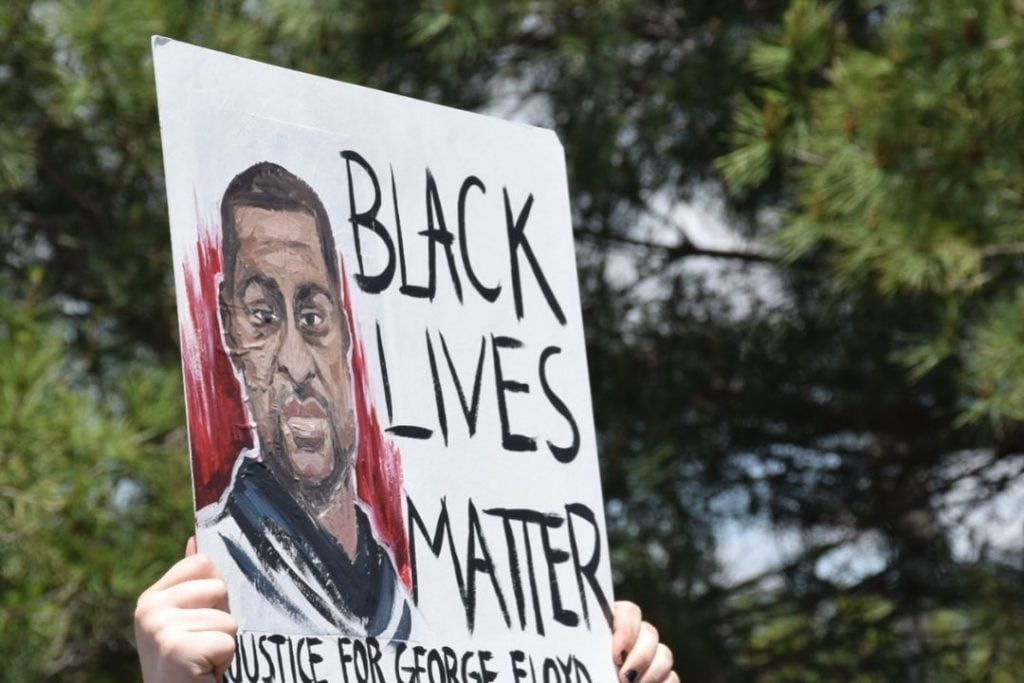
(Britnee Elaine)
“This is about #GeorgeFloyd and about so much more than him…It’s about the thousands of folks who are killed by police every year, including #KennethRossJr, #WakieshaWilson, #GrecharioMack, #RyanTwyman and #LeeJefferson, whose families were all at the protest,” Melina Abdullah, a co-founder of Black Lives Matter Los Angeles, wrote in a statement to the Weekly. “This is also about a system of policing that puts targets on the backs of black people and eats up public funds which could be used for resources and services, like permanent housing, healthcare, youth programs, parks and libraries.”
Protests continued Tuesday, as hundreds marched the streets of L.A. County, from downtown L.A. and Hollywood to Manhattan Beach, Pasadena and even Windsor Square, where Mayor Garcetti resides.
Some made their way to City Hall, where they met without incident both LAPD and National Guard members. At several points, protesters kneeled for eight-minute tributes. Garcetti at one point joined in.
Hundreds that gathered in front of the mayor’s home stayed past the curfew, continuing to chant, although it did not appear that the mayor was there.
Addressing Angelenos from City Hall, Garcetti said that he did not plan on implementing a weeklong curfew, but would take things day-to-day. Earlier that evening, L.A. County Sheriff Alex Villanueva insisted in an interview with KTLA 5 that curfews would continue “until organized protests are gone.” Critics such as the ACLU have labeled the restrictions unconstitutional and counterproductive.
As the 6 p.m. curfew went into effect, handfuls of protesters lingered throughout L.A. Some allowed themselves to be arrested; others scattered to avoid police. On Wednesday, BLM-LA will protest in front of the Hall of Justice at 3 p.m.
Advertising disclosure: We may receive compensation for some of the links in our stories. Thank you for supporting LA Weekly and our advertisers.

